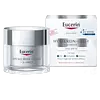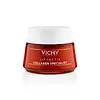What's inside
What's inside
 Key Ingredients
Key Ingredients

 Benefits
Benefits

 Concerns
Concerns

 Ingredients Side-by-side
Ingredients Side-by-side

Water
Skin ConditioningGlycerin
HumectantButyl Methoxydibenzoylmethane
UV AbsorberEthylhexyl Salicylate
UV AbsorberOctocrylene
UV AbsorberButylene Glycol
HumectantGlyceryl Stearate Citrate
EmollientHydrogenated Coco-Glycerides
EmollientButyrospermum Parkii Butter
Skin ConditioningDimethicone
EmollientMethylpropanediol
SolventStearyl Alcohol
EmollientCetyl Alcohol
EmollientGlycine Soja Germ Extract
EmollientSodium Hyaluronate
HumectantMica
Cosmetic ColorantSilica
AbrasiveAcrylates/C10-30 Alkyl Acrylate Crosspolymer
Emulsion StabilisingCarbomer
Emulsion StabilisingTrisodium EDTA
1,2-Hexanediol
Skin ConditioningPhenoxyethanol
PreservativeParfum
MaskingBHT
AntioxidantCI 77891
Cosmetic ColorantWater, Glycerin, Butyl Methoxydibenzoylmethane, Ethylhexyl Salicylate, Octocrylene, Butylene Glycol, Glyceryl Stearate Citrate, Hydrogenated Coco-Glycerides, Butyrospermum Parkii Butter, Dimethicone, Methylpropanediol, Stearyl Alcohol, Cetyl Alcohol, Glycine Soja Germ Extract, Sodium Hyaluronate, Mica, Silica, Acrylates/C10-30 Alkyl Acrylate Crosspolymer, Carbomer, Trisodium EDTA, 1,2-Hexanediol, Phenoxyethanol, Parfum, BHT, CI 77891
Water
Skin ConditioningGlycerin
HumectantDimethicone
EmollientIsohexadecane
EmollientAlcohol Denat.
AntimicrobialSilica
AbrasiveHydroxyethylpiperazine Ethane Sulfonic Acid
BufferingPropanediol
SolventSynthetic Wax
AbrasivePEG-10 Dimethicone
Skin ConditioningEperua Falcata Bark Extract
Skin ProtectingPEG-30 Dipolyhydroxystearate
EmulsifyingStearyl Alcohol
EmollientSorbitan Oleate
EmulsifyingDimethicone/PEG-10/15 Crosspolymer
Dimethicone/Polyglycerin-3 Crosspolymer
CleansingCeteareth-6
EmulsifyingSodium Acrylates Copolymer
Sodium Citrate
BufferingSodium Hydroxide
BufferingSodium Phytate
Cyclodextrin
AbsorbentAdenosine
Skin ConditioningAscorbyl Glucoside
AntioxidantNylon-12
Isopropyl Alcohol
SolventPropylene Carbonate
SolventDipropylene Glycol
HumectantCaprylic/Capric Triglyceride
MaskingCaprylyl Glycol
EmollientAcetyl Tetrapeptide-9
Skin ConditioningSynthetic Fluorphlogopite
Disteardimonium Hectorite
StabilisingDextrin
AbsorbentPisum Sativum Extract
Skin ConditioningTocopherol
AntioxidantPhenoxyethanol
PreservativeCI 15985
Cosmetic ColorantCI 77891
Cosmetic ColorantParfum
MaskingWater, Glycerin, Dimethicone, Isohexadecane, Alcohol Denat., Silica, Hydroxyethylpiperazine Ethane Sulfonic Acid, Propanediol, Synthetic Wax, PEG-10 Dimethicone, Eperua Falcata Bark Extract, PEG-30 Dipolyhydroxystearate, Stearyl Alcohol, Sorbitan Oleate, Dimethicone/PEG-10/15 Crosspolymer, Dimethicone/Polyglycerin-3 Crosspolymer, Ceteareth-6, Sodium Acrylates Copolymer, Sodium Citrate, Sodium Hydroxide, Sodium Phytate, Cyclodextrin, Adenosine, Ascorbyl Glucoside, Nylon-12, Isopropyl Alcohol, Propylene Carbonate, Dipropylene Glycol, Caprylic/Capric Triglyceride, Caprylyl Glycol, Acetyl Tetrapeptide-9, Synthetic Fluorphlogopite, Disteardimonium Hectorite, Dextrin, Pisum Sativum Extract, Tocopherol, Phenoxyethanol, CI 15985, CI 77891, Parfum
 Reviews
Reviews

Ingredients Explained
These ingredients are found in both products.
Ingredients higher up in an ingredient list are typically present in a larger amount.
Ci 77891 is a white pigment from Titanium dioxide. It is naturally found in minerals such as rutile and ilmenite.
It's main function is to add a white color to cosmetics. It can also be mixed with other colors to create different shades.
Ci 77891 is commonly found in sunscreens due to its ability to block UV rays.
Learn more about CI 77891Dimethicone is a type of synthetic silicone created from natural materials such as quartz.
What it does:
Dimethicone comes in different viscosities:
Depending on the viscosity, dimethicone has different properties.
Ingredients lists don't always show which type is used, so we recommend reaching out to the brand if you have questions about the viscosity.
This ingredient is unlikely to cause irritation because it does not get absorbed into skin. However, people with silicone allergies should be careful about using this ingredient.
Note: Dimethicone may contribute to pilling. This is because it is not oil or water soluble, so pilling may occur when layered with products. When mixed with heavy oils in a formula, the outcome is also quite greasy.
Learn more about DimethiconeGlycerin is already naturally found in your skin. It helps moisturize and protect your skin.
A study from 2016 found glycerin to be more effective as a humectant than AHAs and hyaluronic acid.
As a humectant, it helps the skin stay hydrated by pulling moisture to your skin. The low molecular weight of glycerin allows it to pull moisture into the deeper layers of your skin.
Hydrated skin improves your skin barrier; Your skin barrier helps protect against irritants and bacteria.
Glycerin has also been found to have antimicrobial and antiviral properties. Due to these properties, glycerin is often used in wound and burn treatments.
In cosmetics, glycerin is usually derived from plants such as soybean or palm. However, it can also be sourced from animals, such as tallow or animal fat.
This ingredient is organic, colorless, odorless, and non-toxic.
Glycerin is the name for this ingredient in American English. British English uses Glycerol/Glycerine.
Learn more about GlycerinParfum is a catch-all term for an ingredient or more that is used to give a scent to products.
Also called "fragrance", this ingredient can be a blend of hundreds of chemicals or plant oils. This means every product with "fragrance" or "parfum" in the ingredients list is a different mixture.
For instance, Habanolide is a proprietary trade name for a specific aroma chemical. When used as a fragrance ingredient in cosmetics, most aroma chemicals fall under the broad labeling category of “FRAGRANCE” or “PARFUM” according to EU and US regulations.
The term 'parfum' or 'fragrance' is not regulated in many countries. In many cases, it is up to the brand to define this term.
For instance, many brands choose to label themselves as "fragrance-free" because they are not using synthetic fragrances. However, their products may still contain ingredients such as essential oils that are considered a fragrance by INCI standards.
One example is Calendula flower extract. Calendula is an essential oil that still imparts a scent or 'fragrance'.
Depending on the blend, the ingredients in the mixture can cause allergies and sensitivities on the skin. Some ingredients that are known EU allergens include linalool and citronellol.
Parfum can also be used to mask or cover an unpleasant scent.
The bottom line is: not all fragrances/parfum/ingredients are created equally. If you are worried about fragrances, we recommend taking a closer look at an ingredient. And of course, we always recommend speaking with a professional.
Learn more about ParfumPhenoxyethanol is a preservative that has germicide, antimicrobial, and aromatic properties. Studies show that phenoxyethanol can prevent microbial growth. By itself, it has a scent that is similar to that of a rose.
It's often used in formulations along with Caprylyl Glycol to preserve the shelf life of products.
Silica, also known as silicon dioxide, is a naturally occurring mineral. It is used as a fine, spherical, and porous powder in cosmetics.
Though it has exfoliant properties, the function of silica varies depending on the product.
The unique structure of silica enhances the spreadability and adds smoothness, making it a great texture enhancer.
It is also used as an active carrier, emulsifier, and mattifier due to its ability to absorb excess oil.
In some products, tiny microneedles called spicules are made from silica or hydrolyzed sponge. When you rub them in, they lightly polish away dead skin layers and enhance the penetration of active ingredients.
Learn more about SilicaStearyl Alcohol is a type of fatty alcohol from stearic acid. It is a white, waxy compound used to emulsify ingredients.
Fatty Alcohols are most often used as an emollient or to thicken a product. Emollients help soothe and hydrate the skin by trapping moisture.
They are usually derived from natural fats and oils and therefore do not have the same drying or irritating effect as solvent alcohols. FDA allows products labeled "alcohol-free" to have fatty alcohols.
Learn more about Stearyl AlcoholWater. It's the most common cosmetic ingredient of all. You'll usually see it at the top of ingredient lists, meaning that it makes up the largest part of the product.
So why is it so popular? Water most often acts as a solvent - this means that it helps dissolve other ingredients into the formulation.
You'll also recognize water as that liquid we all need to stay alive. If you see this, drink a glass of water. Stay hydrated!
Learn more about Water